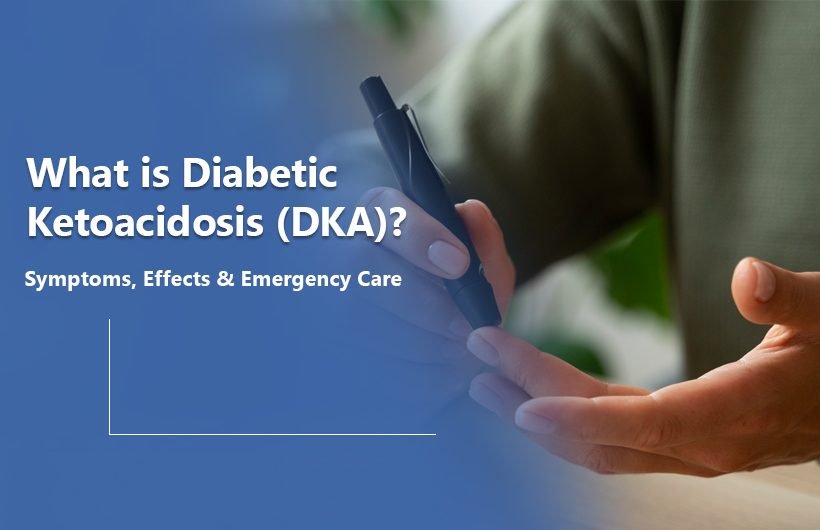If you or a loved one lives with diabetes, understanding diabetic ketoacidosis (DKA) is crucial. DKA is a serious complication of diabetes that requires immediate medical attention. Recognizing it early can save lives.
In this guide, Diabetic Doctor in Ahmedabad, Dr. Moxit Shah explains what diabetic ketoacidosis is, its causes, how it affects your body, the warning signs to watch for, and why it’s considered a medical emergency.
What Is Diabetic Ketoacidosis?
DKA happens when your body doesn’t have enough insulin to let glucose (sugar) enter your cells for energy. Instead, it starts breaking down fat for fuel. This process creates ketones, which build up in the blood and make it acidic.
- DKA is most common in type 1 diabetes, but people with type 2 diabetes can also develop it, especially during illness or severe stress.
- Without prompt treatment, DKA can lead to coma or death.
What Causes Diabetic Ketoacidosis?
Several factors can trigger DKA. The most common causes include:
- Insulin deficiency: Missing insulin doses or using an inadequate insulin dose means glucose stays in your blood instead of fueling your cells.
- Infection or illness: When sick, your body releases stress hormones that counteract insulin.
- Uncontrolled blood sugar: Chronic high blood sugar (hyperglycemia) increases DKA risk.
- Physical or emotional stress: Surgery, trauma, or even severe stress can trigger DKA.
- Undiagnosed diabetes: Some people discover they have diabetes only after experiencing DKA.
How it happens
Without enough insulin:
- The body burns fat for energy.
- This produces ketones, which make the blood acidic (ketoacidosis).
- High blood sugar causes increased urination, leading to dehydration and loss of electrolytes.
What are the Effects of Ketoacidosis on the Body?
When DKA sets in, it affects almost every system in your body:
- Severe dehydration from excessive urination
- Electrolyte imbalance, impacting heart and nerve function
- Nausea, vomiting, and abdominal pain
- Fatigue and confusion due to altered brain function
- Rapid breathing (Kussmaul respiration) as your body tries to balance acidity
- Coma or even death if untreated
That’s why diabetic ketoacidosis is considered a medical emergency.
Signs and Symptoms of Diabetic Ketoacidosis
Recognizing DKA early can prevent serious complications. Watch for these warning signs:
- Excessive thirst
- Frequent urination
- Dry mouth and skin
- Nausea or vomiting
- Stomach pain
- Fruity-scented breath (due to ketones)
- Rapid, deep breathing
- Weakness or fatigue
- Confusion or difficulty concentrating
If you notice these symptoms, especially together, seek medical care immediately.
How is Diabetic Ketoacidosis Diagnosed?
If DKA is suspected, your doctor will run a few tests:
- Blood sugar test: Checks for high glucose levels.
- Urine or blood ketone test: Detects excess ketones.
- Blood gas analysis: Measures how acidic your blood has become.
- Electrolyte tests: Look for imbalances like low potassium.
These tests help doctors determine the severity and guide treatment.
Emergency Treatment and Prevention
How is DKA treated?
DKA usually requires hospitalization and involves:
- IV fluids: To correct dehydration.
- Insulin therapy: Lowers blood sugar and stops ketone production.
- Electrolyte replacement: Restores critical minerals like potassium.
Most people start feeling better within 24 hours of treatment, but it may take longer to fully normalize lab values.
How can you prevent diabetic ketoacidosis?
The good news? DKA is often preventable with good diabetes management.
- Monitor blood sugar regularly.
- Never skip insulin or oral diabetes medications.
- Check ketones during illness or when blood sugar is persistently high (>250 mg/dL).
- Stay hydrated.
- Have a sick-day plan and contact your doctor if unsure.
When to Go to the Emergency Room
Go to the ER immediately if you:
- Have persistent nausea, vomiting, or stomach pain
- Notice fruity-smelling breath or deep, rapid breathing
- Feel very drowsy or confused
- Can’t keep fluids down or stop urinating
Final Thoughts
Diabetic ketoacidosis is preventable and treatable, especially when caught early. By monitoring your blood sugar, taking insulin as prescribed, and knowing the warning signs, you can protect yourself from this life-threatening complication.
If you have concerns about your diabetes management or have experienced any of the symptoms above, schedule a consultation with Dr. Moxit Shah today.
FAQs
What is diabetic ketoacidosis?
DKA is a dangerous complication of diabetes where lack of insulin causes the body to burn fat for energy, creating acidic ketones that build up in the blood.
How serious is diabetic ketoacidosis?
It’s very serious. Without prompt treatment, DKA can lead to coma or death.
What are the warning signs of ketoacidosis?
- Excessive thirst
- Frequent urination
- Nausea, vomiting
- Abdominal pain
- Fruity breath
- Rapid breathing
- Confusion
Can type 2 diabetics get ketoacidosis?
Yes. Though more common in type 1 diabetes, people with type 2 can develop DKA, especially during illness or severe stress.
What happens if DKA is left untreated?
Blood becomes dangerously acidic, leading to organ failure, coma, or death.






